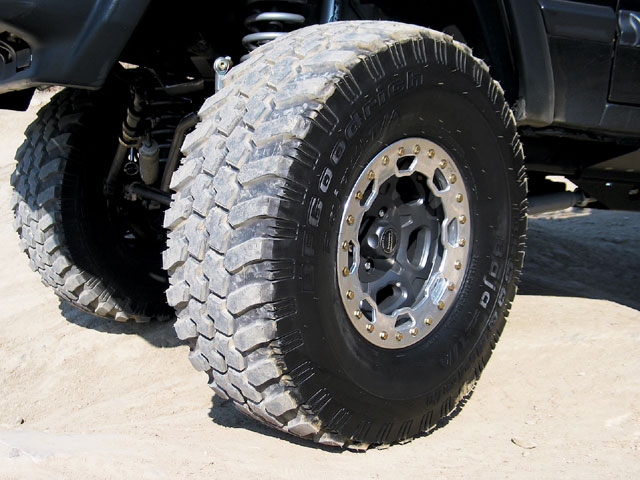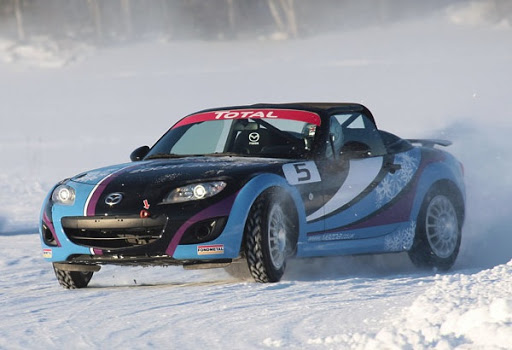The Physics of Off-Roading
By: Nicholas Beeker
Tires
Tires are the other key component when considering an off roading adventure. The type of tires you get are unlike your typical street tires as you will not be traveling on normal paved surfaces. The right choice in tires can make the difference between a good day and getting a ride home. When you are driving around on paved roads the friction coefficient between your tires and the road remains more or less constant and consistent. The surface is even and very solid so a tire with lots of smooth flat contact patches is very beneficial. When you are not on the pavement however the surface can vary greatly even as little as a foot away. You are driving on loose terrain which is not very solid and in most cases has a much lower coefficient of friction. This means that you will need more surface area to make up for the loss of friction. The main ways to do this are larger and wider/narrower tires, airing down, and tread choice.
Tire Size
By using a wider and larger tire on your off road vehicle
you are increasing the contact patch between the tire and
the ground. With this larger contact patch you are
increasing the area in which the friction forces can act
upon the tire. You are also increasing the weight which is
acting down on the the ground. This is a very complicated
part of the choice as the type of terrain dictates what you
should get as far as going with a wider or narrow tire. A
wide tire is good for surfaces like sand and mud where you
want to stay above the surface of the terrain.
By having a wider tire you are allowing the weight of the
tire to be spread over a much greater surface area which
means less lb/in^2 acting down on the ground. A very handy
experiment you can use is pushing a pencil into a sand box,
then repeat the experiment but place a quarter flat on the
sand then push down on the quarter with the pencil. By
putting the quarter down you increased the surface area and
it required a significant amount more effort to push it into
the sand right? This is true with tires as well. The larger
tire will have a harder time sinking into the sand.
Another way to further increase the surface area of your
tire is to "air it down" or let the air out so that the
pressure in the tire is lower. The pressure in the tire is
what keeps the tire inflated and round. By letting some out
you allow it to sink an bit and the contact patch increases
even more. This allows more grip and as a bonus the tire can
now deform more when impacting rocks and other objects and
form around it and contact more surface area.

(Taken From:
http://www.expeditionportal.com/forum/threads/42186-Question-about-BFG-BAJA-T-A)
The second argument is narrower tires which being in Alaska
and working for tire sops I have always heard "run narrow
tires in the winter" because it increases the force the
tires exert through a smaller contact patch. Which using
physics you can determine like above the smaller the contact
patch the larger the lb/in^2 increase. On hard low friction
surfaces such as ice or rocks this can come in handy as you
exert more force on the smaller patch the traction is much
greater then you would get with a wider tire. This is
somewhat hard for me to explain as you would think the
larger surface area would apply here and more is better but
somehow it isn't.

(Taken From:
http://bayourenaissanceman.blogspot.com/2011/03/convertibles-on-ice.html)
Tread Design and Compounds
The design of the tire and the compounds that it is made
out of greatly affect the performance of the tire in
different situations. First the compound of rubber is a big
one that applies to both street and off road tires. The
compound of the rubber basically affects the friction that
the tire itself has when acting against other surfaces. Many
race cars on rock crawling buggies use a soft and sticky
compound because of the greater coefficient of fiction which
allows them to apply more rotational torque to the surface
and not slide around as much as a harder tire. On a rock
buggy they want the rotational force to be higher in order
to pull a heavy buggy up a slippery rock slope and using the
sticky rubber can make up for the lack of friction on the
rocks. The other part is the design of the tread, most off
road vehicles use a tire called an mud tire or for some an
"extreme traction" tire. The mud tire is designed with
larger voids between the big chunks of tread which is
perfect in an off road environment because the loose surface
can squeeze between the voids and further increase the
contact patch as well as use the surfaces friction against
itself by dragging it along between the tread blocks.

(Taken From: http://www.intercotire.com/tires.php?id=13)